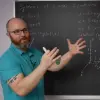

NARROW DISPLAY WARNING
You are most likely using a tablet or mobile device in portrait orientation. This website is best viewed using a typical computer screen with the browser window maximized.
Viewing this website in portrait orientation can cause problems with equations being longer than the screen width (you can scroll to the right), images being poorly sized, and the font size of maths text being much smaller than regular text. If your only option is a tablet or mobile device, your viewing experience will be better if you view this website in landscape orientation. You might need to refresh the page to fix any problems after rotating.
Welcome to the Linear Algebra course. The Table of Contents on the left has all the topics for the course, with expanded descriptions below. When you hover over the link to a page, the text will become underlined.
🡽Systems of Linear Equations — Linear algebra is all about solving systems of linear equations. The "linear" part means equations of lines, equations of planes, and so on. There are no terms like $x^{2}$ or $\sin(y)$ or $e^{z}$ or any other nonlinear terms. The only equations allowed are a number times $x$ plus a number times $y$ equals a number, or a number times $x$ plus a number times $y$ plus a number times $z$ equals a number, and so on with any number of variables. The "system" part means a set of linear equations, all of which need to be solved by the same $(x,y)$ pair in two dimensions, solved by the same $(x,y,z)$ triple in three dimensions, and so on for higher dimensions.
Vectors
Fundamentals🡽 — A vector can be thought of geometrically as an arrow, which has a magnitude, or length, and direction. They are used in multivariable calculus and extensively in physics, such as electromagnetic fields, gravitational fields, and fluid flow.
$\vec{a} \cdot \vec{b}$ Dot Product🡽 — The dot product, or inner product, can be used to find the angle between a pair of vectors, test if a pair of vectors is parallel or perpendicular, and find the projection of a vector onto another vector. The name "dot product" is comes from the dot operator that is used to represent the operation. Another name is scalar product which emphasizes the output is a scalar.
$\vec{a} \times \vec{b}$ Cross Product🡽 — The cross product, or vector product, calculates a vector perpendicular to a pair of input vectors. The name comes from the operator between the two input vectors, which is an "x" with right angles. The direction of the output vector follows the right hand rule with the order of the two input vectors and has magnitude equal to the parallelogram formed by the two input vectors. It is used extensively in vector calculus and physics.
Normal $\vec{n}$ to Plane🡽 — A quick way to create a vector perpendicular to a plane is to write the equation of the plane as a dot product of the coefficients on x, y, and z with vector [x,y,z] equal to a constant. The vector of coefficients is perpendicular to the plane, called a normal vector to the plane.
🡽Linear Equations and Vectors — Systems of linear equations can be interpreted as intersections of lines and planes and higher-dimensional linear objects, but another way is to interpret solutions of systems of linear equations as a linear combination of vectors.